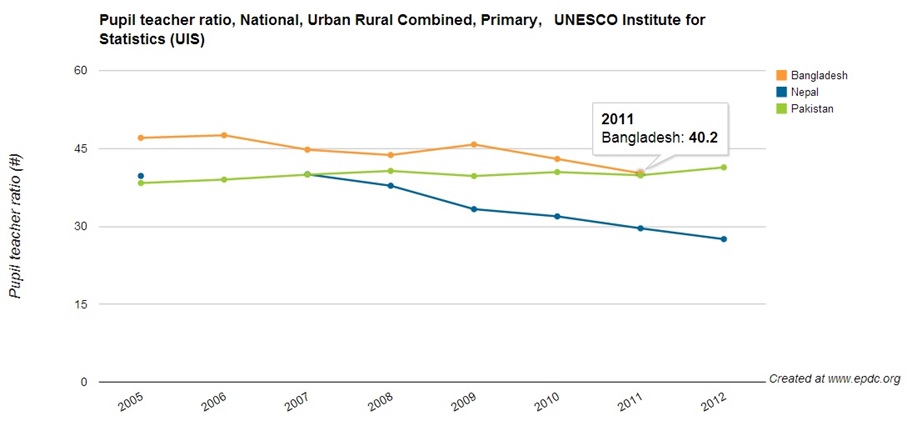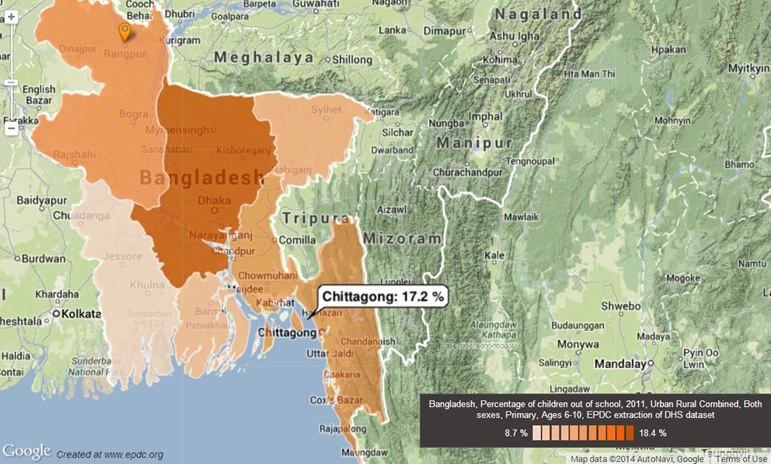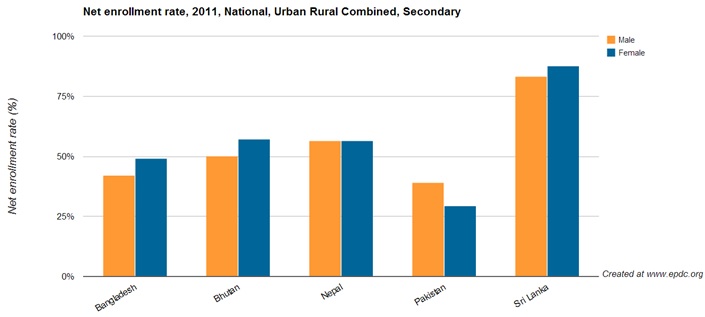You are here
EPDC Spotlight on Bangladesh
EPDC Spotlight on Bangladesh
Each week, the EPDC Data Points blog will highlight a different country and the resources we offer, such as data, country profiles, research or other tools that users have available to them through the website. This week Bangladesh is featured, and Kemi Oyewole, an intern in EPDC, provides an overview of education in the country and the data resources we have that are publicly available.
Bangladesh is a low income, South Asian country that is one of the ten most populous in the world.[i] Additionally, 31 percent Bangladeshi population is under the age of 15. Thus provision of a quality basic education has the potential to transform the nation in a single generation. In Bangladesh, the formal education system begins at the primary level when students are six years of age. Five years of primary school are followed by three years of lower secondary school, four years of upper secondary school, and opportunities for university or vocational education. In principle, primary education in Bangladesh is free and compulsory.
Learning Outcomes
Bangladeshi students sit for the Secondary School Certificate examination at the conclusion of lower secondary school and the Higher Secondary Certificate at the conclusion of upper secondary school. Periodically, national assessments are administered to students in the third and fifth grades. Phase I of the Education Policy and Data Center (EPDC) National Learning Assessments Mapping found that these national assessments reflect two of the seven domains deemed important for learning by the Brookings Institution and UNESCO Institute for Statistics Learning Metrics Task Force (Literacy & Communication and Numeracy & Mathematics).
Education Data: A Snapshot
Figure 1: Primary School Pupil-Teacher Ratio in Bangladesh, Nepal, and Pakistan
From 2005 to 2011, the primary school pupil-teacher ratio in Bangladesh has declined 14.5 percent to 40.2 pupils per teacher (Figure 1). This change suggests that more resources are being directed towards increasing the number of teachers in the country, even as the number of pupils enrolled in primary school continues to rise. For those students who move forward to secondary school, EPDC estimates for 2014 find 70 percent of females and 57 percent of males complete lower secondary education. However, EPDC Projections for Bangladesh predict that by 2018 lower secondary completion rates will reach 98 percent for females and 87 percent for males.[ii] These promising figures point to an expansion of educational access for Bangladeshi students. The EPDC website has a host of other data on education in Bangladesh including, but not limited to: school participation, gender parity, educational expenditures, and literacy. Further descriptions of education in Bangladesh are available in its Education Profiles.
Addressing Inequality in Education
Figure 2: Percentage of Children Ages 6-11 Out of Primary School
Many students in Bangladesh do not enroll in school or fail to complete basic education due to poverty. The EPDC Out of School Profile for Bangladesh estimates that over 4 million children ages 7 to 14, 16 percent of school aged children, are out of school (Figure 2). The government of Bangladesh has proved successful in increasing enrollment in primary education and achieving gender parity in part through the Primary Education Stipend Program which was introduced in 2002. The stipend program has reached 7.8 million children in a range of government, non-government, community, and madrasas for primary aged students. To build upon these gains, a 2014 study recommends that investment in the stipend program increases and is more sensitive to the needs of households with multiple children in primary school.[iii]
As presented in an EPDC Policy Brief on Education Inequality between Countries, efforts to increase school attendance prove to be most successful when they are tailored to serve defined groups of marginalized children. The World Bank has supported the Bangladeshi government in addressing the need for rural out-of-school children to complete primary education through the first and second iterations of the Reaching Out-of-School Children project. The program has been successful in reaching out of school students in disadvantaged rural communities through a blend of formal and informal education. By 2017, the program is expected to bring 720,000 children back to school.[iv]
Figure 3: Net Enrollment Rate for Females and Males in Bangladesh
As primary school completion rates increase across Bangladesh, increased attention is directed towards expanding opportunities for secondary and tertiary education. In 2011, 45.6 percent of secondary school aged students were enrolled in secondary school (Figure 3). At the conclusion of 2013, the International Development Association arm of the World Bank committed to $390 million in additional financing for the Bangladeshi Secondary Education Quality and Access Enhancement Project and the Higher Education Quality Enhancement Project. The Secondary Education Quality and Access Enhancement Project will be expanded to provide poverty-targeted stipends and tuition to 4.5 million rural children in 215 upazilas annually, with a special emphasis on the inclusion of girls.[v] Meanwhile the additional financing for the Higher Education Quality Enhancement Project will support academic innovation by offering public and private universities the opportunity to compete for funding through the Academic Innovation Fund[vi].
EPDC Resources
Among other sources, unique EPDC data collections for Bangladesh include administrative data from the Ministry of Education (2005-2011), USAID Demographic and Health Surveys (2000, 2004, 2007, 2011), Household Expenditure Surveys (2000, 2002), UNICEF Multiple Indicator Cluster Survey (2006), and other indicators derived from the UNESCO Institute for Statistics. All of the figures presented in this post were created on the EPDC website which offers users the opportunity to create graphs, charts, and other visualizations of data with an easy-to-use tool.
[i] United States of America Central Intelligence Agency, “The World Factbook: Country Comparison, Population.”
[ii] Completion rates are calculated as: the total number of student completing (or graduating from) the final year of primary or secondary education, regardless of age, expressed as a percentage of the population of the official primary or secondary graduation age.
[iii] UNICEF, “Stipend programme enhances primary school enrollment – dropout and efficiency remain challenging,” last modified February 27, 2014.
[iv] The World Bank, “‘Second Chance’ Education for Children in Bangladesh,” last modified January 27, 2014.
[v] The World Bank, “World Bank to Support 4.5 Million Bangladeshi Poor Students to Continue Secondary Level Education,” last modified February 26, 2014.
[vi] The World Bank, “World Bank Provides $390 Million to Enhance Support for Secondary and Higher Education in Bangladesh,” last modified December 5, 2013.




Add new comment